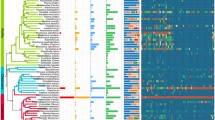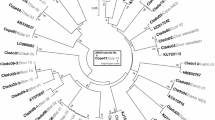Abstract
DNA barcoding provides accurate identification of zooplankton species through all life stages. Single-gene-targeted metagenomic analysis based on DNA barcode databases can facilitate longterm monitoring of zooplankton communities. With the help of the available zooplankton databases, the zooplankton community of the Changjiang (Yangtze) River estuary was studied using a single-gene-targeted metagenomic method to estimate the species richness of this community. A total of 856 mitochondrial cytochrome oxidase subunit 1 (cox1) gene sequences were determined. The environmental barcodes were clustered into 70 molecular operational taxonomic units (MOTUs). Forty-two MOTUs matched barcoded marine organisms with more than 90% similarity and were assigned to either the species (similarity>96%) or genus level (similarity<96%). Sibling species could also be distinguished. Many species that were overlooked by morphological methods were identified by molecular methods, especially gelatinous zooplankton and merozooplankton that were likely sampled at different life history phases. Zooplankton community structures differed significantly among all of the samples. The MOTU spatial distributions were influenced by the ecological habits of the corresponding species. In conclusion, single-gene-targeted metagenomic analysis is a useful tool for zooplankton studies, with which specimens from all life history stages can be identified quickly and effectively with a comprehensive database.
Similar content being viewed by others
References
Baird H P, Miller K J, Stark J S. 2011. Evidence of hidden biodiversity, ongoing speciation diverse patterns of genetic structure in giant Antarctic amphipods. Molecular Ecology, 20(16): 3 439–3 454.
Beaugrand G. 2009. Decadal changes in climate and ecosystems in the North Atlantic Ocean and adjacent seas. Deep-Sea Research, Part II, 56(8–10): 656–673.
Bensasson D, Zhang D X, Hartl D L, Hewitt G M. 2001. Mitochondrial pseudogenes: evolution’s misplaced witnesses. Trends in Ecology & Evolution, 16(6): 314–321.
Browne W E, Haddock S H D, Martindale M Q. 2007. Phylogenetic analysis of lineage relationships among hyperiid amphipods as revealed by examination of the mitochondrial gene, cytochrome oxidase I (COI). Integrative and Comparative Biology, 47(6): 815–830.
Bucklin A, Frost B W, Bradford-Grieve J, Allen L D, Copley N J. 2003. Molecular systematic phylogenetic assessment of 34 calanoid copepod species of the Calanidae and Clausocalanidae. Marine Biology, 142(2): 333–343.
Bucklin A, Hopcroft R R, Kosobokova K N, Nigro L M, Ortman B D, Jennings R M, Sweetman C J. 2010a. DNA barcoding of Arctic Ocean holozooplankton for species identification andrecognition. Deep-Sea Research, Part II, 57(1–2): 40–48.
Bucklin A, Ortman B, Jennings R, Nigro L, Sweetman C, Copley N, Sutton T, Wiebe P. 2010b. A “Rosetta Stone” for metazoan zooplankton: DNA barcode analysis of species diversity of the Sargasso Sea (Northwest Atlantic Ocean). Deep-Sea Research, Part. II, 57(24–26): 2 234–2 247.
Bucklin A, Steinke D, Blanco-Bercial L. 2011. DNA Barcoding of marine metazoa. Annual Review of Marine Science, 3: 471–508.
Bucklin A, Wiebe P H, Smolenack S B, Copley N J, Beaudet J G, Bonner K G, Farber-Lorda J, Pierson J J. 2007. DNA barcodes for species identification of euphausiids (Euphausiacea, Crustacea). Journal of Plankton Research, 29(6): 483–493.
Carvalho G, Creer S, Allen M J, Costa F, Tsigenopoulos C, Le Goff-Vitry M, Magoulas A, Medlin L, Metfies K. 2010. Genomics in the discovery and monitoring of marine biodiversity. Introduction to Marine Genomics. p.1–32.
Cheng F P, Wang M X, Sun S, Li C L, Zhang Y S. 2013. DNA barcoding of Antarctic marine zooplankton for species indetification and recognition. Advances in Polar Science, 24(2): 119–127.
Cowen R K, Paris C B, Srinivasan A. 2006. Scaling of connectivity in marine populations. Science, 311(5760): 522–527.
Crandall K. 2009. Workshops Report and Recommendations, DNA barcoding of Marine Biodiversity, http://www.cmarz.org/barcode/pdf/MarBOL_Workshops_Report_06jul09.pdf. Accessed on 2009-07-06.
Creer S, Fonseca V G, Porazinska D L, Giblin-Davis R M, Sung W, Power D M, Packer M, Carvalho G R, Blaxter M L, Lambshead P J D, Thomas W K. 2010. Ultrasequencing of the meiofaunal biosphere: practice, pitfalls and promises. Molecular Ecology, 19(s1): 4–20.
Dawson M N, Jacobs D K. 2001. Molecular evidence for cryptic species of Aurelia aurita (Cnidaria, Scyphozoa). Biological Bulletin, 200(1): 92–96.
Ewing B, Green P. 1998. Base-calling of automated sequencer traces using phred. II. Error probabilities. Genome Research, 8(3): 186–194.
Ewing B, Hillier L, Wendl M C, Green P. 1998. Base-calling of automated sequencer traces using phred. I. Accuracy assessment. Genome Research, 8(3): 175–185.
Folmer O, Black M, Hoeh W, Lutz R, Vrijenhoek R. 1994. DNA primers for amplification of mitochondrial cytochrome c oxidase subunit I from diverse metazoan invertebrates. Molecular Marine Biology and Biotechnology, 3(5): 294–299.
Gordon D, Abajian C, Green P. 1998. Consed: a graphical tool for sequence finishing. Genome Research, 8(3): 195–202.
Harris R, Wiebe P, Lenz J, Skjoldal H, Huntley M. 2000. ICES Zooplankton Methodology Manual. Academic Press, San Diego, US.
Hua X, Wang W, Yin W, He Q, Jin B, Li J, Chen J, Fu C. 2009. Phylogeographical analysis of an estuarine fish, Salanx ariakensis (Osmeridae: Salanginae) in the north-western Pacific. Journal of Fish Biology, 75(2): 354–367. (in Chinese with English abstract)
Jennings R M, Bucklin A, Ossenbrügger H, Hopcroft R R. 2010a. Species diversity of planktonic gastropods (Pteropoda and Heteropoda) from six ocean regions based on DNA barcode analysis, Deep-Sea Research, Part II, 57(24–26): 2 199–2 210.
Jennings R M, Bucklin A, Pierrot-Bults A. 2010b. Barcoding of arrow worms (Phylum Chaetognatha) from three oceans: genetic diversity and evolution within an enigmatic phylum. Plo S One, 5(3): e9949.
Knowlton N. 1993. Sibling species in the sea. Annual Review of Ecology Evolution and Systematics, 24: 189–216.
Ko H L, Wang Y T, Chiu T S, Lee M A, Leu M Y, Chang K Z, Chen W Y, Shao K T. 2013. Evaluating the accuracy of morphological identification of larval fishes by applying DNA barcoding. Plo S One, 8(1): e53451.
Kochzius M, Nolte M, Weber H, Silkenbeumer N, Hjorleifsdottir S, Hreggvidsson G O, Marteinsson V, Kappel K, Planes S, Tinti F, Magoulas A, Vazquez E G, Turan C, Hervet C, Falgueras D C, Antoniou A, Landi M, Blohm D. 2008. DNA microarrays for identifying fishes. Marine Biotechnology, 10(2): 207–217.
Lee G, Park S Y, Hwang J, Lee Y H, Hwang S Y, Lee S, Lee T K. 2011. Development of DNA chip for jellyfish verification from South Korea. Biochip Journal, 5(4): 375–382.
Li C L, Wang M X, Cheng F P, Sun S. 2011. DNA barcoding and its application to marine zooplankton ecology. Biodiversity Science, 19(06): 805–814. (in Chinese with English abstract)
Lin Y. 1985. Vertical distribution of chaetognaths in the East China Sea in summer of 1978. Acta Ecologica Sinica, 5(2): 175–186. (in Chinese with English abstract)
Liu Z S. 2012. Community Structure and Biodiversity of Zooplankton in the Changjiang Estuary and Its Adjacent Waters. PhD dissertation, Ocean University of China. 154p. (in Chinese with English abstract)
Machida R J, Hashiguchi Y, Nishida M, Nishida S. 2009. Zooplankton diversity analysis through single-gene sequencing of a community sample. BMC Genomics, 10(1): 438.
Miyamoto H, Machida R J, Nishida S. 2010. Genetic diversity and cryptic speciation of the deep sea chaetognath Caecosagitta macrocephala (Fowler, 1904). Deep-Sea Research, Part II, 57(24): 2 211–2 219.
Miyamoto H, Machida R J, Nishida S. 2012. Global phylogeography of the deep-sea pelagic chaetognath Eukrohnia hamata. Progress in Oceanography, 104: 99–109.
Ortman B. 2008. DNA Barcoding the Medusozoa and Ctenophora. PhD dissertation, University of Connecticut. 134p.
Ortman B, Bucklin A, Pages F, Youngbluth M. 2010. DNA Barcoding the Medusozoa using mtCOI. Deep-Sea Research, Part II, 57(24): 2 148–2 156.
Planque B, Taylor A H. 1998. Long-term changes in zooplankton and the climate of the North Atlantic. ICES Journal of Marine Science, 55(4): 644–654.
Radulovici A E, Archambault P, Dufresne F. 2010. DNA barcodes for marine biodiversity: moving fast forward? Diversity, 2(4): 450–472.
Schloss P D, Westcott S L, Ryabin T, Hall J R, Hartmann M, Hollister E B, Lesniewski R A, Oakley B B, Parks D H, Robinson C J, Sahl J W, Stres B, Thallinger G G, Van Horn D J, Weber C F. 2009. Introducing Mothur: opensource, platform-independent, community-supported software for describing and comparing microbial communities. Applied and Environmental Microbiology, 75(23): 7 537–7 541.
Sirovich L, Stoeckle M Y, Zhang Y. 2009. A scalable method for analysis and display of DNA sequences. PLoS One, 4(10): e7051.
Sun G, Zhu Y, Zhou Z, Chen J. 1994. The reproductive biology of Lateolabrax japonicus in the Yangzi River estuary and Zhejiang offshore waters. Journal of Fishery Science of China, 18(1): 18–23. (in Chinese with English abstract)
Swofford D L. 1993. Paup-a computer-program for phylogenetic inference using maximum parsimony. Journal of General Physiology, 102(6): A9.
Tamura K, Peterson D, Peterson N, Stecher G, Nei M, Kumar S. 2011, MEGA5: molecular evolutionary genetics analysis using maximum likelihood, evolutionary distance, and maximum parsimony methods. Molecular Biology and Evolution, 28(10): 2 731–2 739.
Uye S, Aoto I, Onbe T. 2002. Seasonal population dynamics and production of Microsetella norvegica, a widely distributed but little-studied marine planktonic harpacticoid copepod. Journal of Plankton Research, 24(2): 143–153.
Valentini A, Pompanon F, Taberlet P. 2009. DNA barcoding for ecologists. Trends in Ecology & Evolution, 24(2): 110–117.
Wang M X. 2010. Application of Molecular Markers to the Researches on Pelagic Copepods in the Chinese Coastal Regions. PhD dissertation. Institute of Oceanography, Chinese Academy of Sciences. 164p. (in Chinese with English abstract)
Wang M X, Cheng F P, Li C L, Sun S. 2011a. DNA barcoding of zooplankton of zooplankton in the Jiaozhou Bay for species identification. Oceanologia et Limnologia Sinica, 42(5): 702–710. (in Chinese with English abstract)
Wang R C, Wang M X, Cheng F P, Li C L, Sun S. 2011b. species composition analysis of zooplankton in the Jiaozhou Bay using environmental barcoding of the mitochondrial cox1 gene. Oceanologia et Limnologia Sinica, 42(5): 711–721. (in Chinese with English abstract)
Xiao Y C. 2004. Fauna Sinica Invertebrata (Vol.38) Chaetognatha: Sagittoidea. Science Press, Beijing. 201p. (in Chinese with English abstract)
Xu Z L, Shen X Q, Yuan Q, Chen Y Q. 2003. Distribution characteristics of zooplankton in waters around Yangshan Islands in Hangzhou Bay. Journal of Fishery Science of China, 27(suppl.): 69–75. (in Chinese with English abstract)
Author information
Authors and Affiliations
Corresponding author
Additional information
Supported by the National Natural Science Foundation of China (No. 41230963), the National Basic Research Program of China (973 Program) (No. 2011CB403604), the “135” Fund of Institute of Oceanology, Chinese Academy of Sciences (No. 2012I0060102), the Innovative Research Group Funding of the National Natural Science Foundation of China (No. 41121064), and the Strategic Priority Research Program of Chinese Academy of Sciences (No. XDA11020305)
CHENG Fangping and WANG Minxiao contributed equally to this work.
Rights and permissions
About this article
Cite this article
Cheng, F., Wang, M., Li, C. et al. Zooplankton community analysis in the Changjiang River estuary by single-gene-targeted metagenomics. Chin. J. Ocean. Limnol. 32, 858–870 (2014). https://doi.org/10.1007/s00343-014-3251-y
Received:
Accepted:
Published:
Issue Date:
DOI: https://doi.org/10.1007/s00343-014-3251-y




